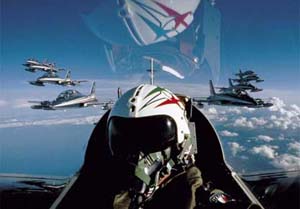 |
|
 |
|
| Visite: 1036 | Gradito: |
Leggi anche appunti:Innovazioni tecniche e scientifiche dal 1900 al 1930INNOVAZIONI TECNICHE E SCIENTIFICHE DAL 1900 AL 1930 1901: prima trasmissione SumeriSumeri Antica popolazione contadina originariamente abitante nell'attuale valle L'india ingleseL'INDIA INGLESE Nel corso del settecento la decadenza attraversata dall'impero |
 |
 |
CONVENTION OF GENEVA
The Geneva Conventions consist of treaties formulated in Geneva, Switzerland that set the standards for international law for humanitarian concerns. The conventions were the results of efforts by Henri Dunant, who was motivated by the horrors of war he witnessed at the Battle of Solferino. In the field, soldiers of a signatory nation who carry prohibited equipment or perform prohibited actions are subject to summary field execution without a trial. This is usually carried out on prisoners of war who are captured with prohibited equipment. It may be ordered by the senior officer of a group that has observed a war crime and can recognize participating individuals. Accusations of violation of the Geneva Conventions on the part of signatory nations are brought before the International Court of Justice at the Hague.
The conventions and their agreements are as follows:
First Geneva Convention (1864): Treatment of battlefield casualties.
Second Geneva Convention (1906): Extended the principles from the first convention to apply also to war at sea.
Third Geneva Convention (1929): Treatment of prisoners of war.
Fourth Geneva Convention (1949): Treatment of civilians during wartime.
This First Convention also mandated the foundation of the International Committee for the Red Cross. The text is given in the Resolutions of the Geneva International Conference.
The conventions were revised and ratified in 1949; the whole is referred to as the 'Geneva Conventions of 1949' or simply the 'Geneva Conventions'. Later conferences have added provisions prohibiting certain methods of warfare and addressing issues of civil wars. Nearly 200 countries are 'signatory' nations, in that they have ratified these conventions.
The 1949 Geneva Convention
The changed methods of warfare in World War II, the maltreatment of prisoners of war that constituted an important part of the war crimes indictments, and the retention of a great number of German prisoners of war by the USSR for several years after the war showed that the 1929 Convention required revision on many points. A new convention, reaffirming and supplementing the 1929 Convention, was signed at Geneva in 1949 and subsequently ratified by almost all nations. It broadened the categories of persons entitled to prisoner-of-war status, clearly redefined the conditions of captivity, and reaffirmed the principle of immediate release and repatriation at the end of hostilities.
Although the North Koreans promised to respect the Geneva Convention in the Korean War, they refused to recognize the impartial status of the Red Cross and denied it access to the territory they controlled. The unprecedented refusal of prisoners to be repatriated, moreover, established a new principle of political asylum for prisoners of war. The governments of North and South Vietnam, parties to the 1949 Geneva Convention, were charged with violating it in the Vietnam War-the North by not permitting full reporting, correspondence, and neutral inspection, and the South by allegedly torturing captives and placing them in inhumane prisons. The national anguish over the Vietnam War was extended for decades after the war's end in part because of the lack of resolution over the POW and MIA (missing in action) issue. While the Pentagon's MIA list still contains names of missing servicemen, the last official prisoner of war was declared dead in 1994.
Prisoners of war, in international law are, persons captured by a belligerent while fighting in the military, in conventional war ostilities. International law includes rules on the treatment of prisoners of war but extends protection only to combatants. This excludes civilians who engage in hostilities (by international law they are war criminals; see war crimes) and forces that do not observe conventional requirements for combatants.
The Geneva Conventions of 1949 provides a framework of protective rights of POWs. The basic principle is that being a soldier is not a punishable act in itself. The laws apply from the moment a prisoner is captured until he is released or repatriated. One of the main provisions of the convention makes it illegal to torture prisoners, and states that a prisoner can only be required to give his name, date of birth, rank and serial number (if applicable).
According to the Article 4 of the Third Geneva Convention, protected combatants includes military personnel, guerrilla fighters and certain civilians.
To be entitled to prisoner of war status, the combatant must conduct operations according to the laws and customs of war, e.g. be part of a chain of command, wear a uniform and bear arms openly. Thus, franc-tireurs, terrorists and spies are excluded. It also does not include unarmed non-combatants who are captured in time of war; they are protected by the Fourth Geneva Convention rather than the Third Geneva Convention.
The United States uses the term enemy prisoner of war (EPW) for hostile forces, reserving the term prisoner of war for its own or Allied forces.
 |
| Appunti su: |
|
| Appunti Architettura |  |
| Tesine Aeronautica |  |
| Lezioni Astronomia cosmologia |  |